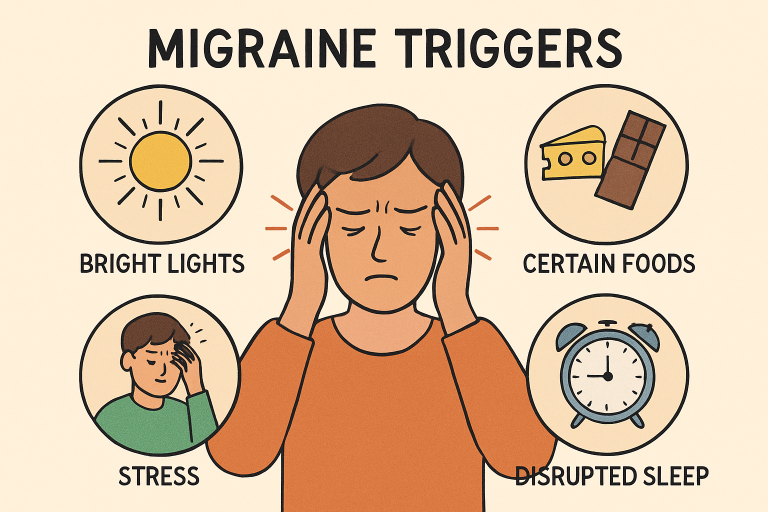Health
How to Recognize and Manage Migraine Triggers
Key Takeaways:
- Identifying personal migraine triggers is crucial for effective management.
- Common triggers include certain foods, stress, sleep disturbances, and environmental factors.
- Maintaining a headache diary can help pinpoint specific triggers.
- Implementing lifestyle changes can reduce the frequency and severity of migraine attacks.
Understanding Migraine Triggers
Migraines impact millions of people each year, often disrupting daily life and productivity. One of the most important steps in managing migraines is learning to recognize individual triggers. Since triggers vary widely among sufferers, what provokes an attack in one person might be harmless to another. Gaining awareness of these triggers can empower individuals to take control of their health and reduce migraine frequency. For those seeking specialized expertise, exploring migraine treatment Jacksonville, FL, can be invaluable in establishing an effective management plan.
Common migraine triggers include dietary factors, stress, disruptions in sleep patterns, and environmental stimuli. Foods such as aged cheeses, chocolate, processed meats, and those containing monosodium glutamate (MSG) are among the most frequently reported dietary triggers. Stress, both its sudden onset and the subsequent relaxation period, also plays a significant role. Irregular sleep—whether too little or too much—along with environmental factors like bright lights, strong odors, and fluctuating weather conditions, are well-documented contributors to migraine attacks.
Understanding the breadth of potential triggers is essential because it helps narrow down the specific catalysts responsible for each individual’s migraines. The unique and personal nature of triggers means that what works for one person’s management may not apply to another. Therefore, a tailored approach is crucial for effective long-term results.
Keeping a Headache Diary
One of the most powerful tools for uncovering migraine patterns is maintaining a headache diary. This simple but effective technique provides clarity in recording daily habits, environmental exposures, and the timing and context of migraine episodes. Such documentation should include the date and time of each migraine, the foods and beverages consumed beforehand, the duration and quality of sleep, stress levels, and any unusual environmental factors encountered. For those who are new to tracking symptoms, mobile apps and printable templates can be useful aids.
Over weeks and months, recurring themes often emerge, allowing individuals to pinpoint their most common triggers. For example, you might notice a consistent pattern of headaches after eating processed foods or following late nights. Identifying these links helps guide more informed choices and targeted lifestyle modifications.
Additionally, headache diaries serve as valuable resources during consultations with healthcare professionals. By presenting concrete data, patients make it easier for specialists to recommend appropriate interventions and treatments tailored to their unique trigger landscape.
Implementing Lifestyle Modifications
After triggers are identified, the next crucial step is making effective lifestyle changes. Simple adjustments can make a significant difference in reducing migraine frequency and severity:
- Maintain a Consistent Sleep Schedule: Aim for regular sleep and wake times, even on weekends, to support your body’s natural rhythms.
- Eat a Balanced Diet: Regular meals—avoiding skipped meals and dehydration—can help prevent hunger-induced migraines. Balanced nutrition, combined with a low intake of processed foods, is key.
- Manage Stress Effectively: Engage in relaxation techniques such as deep breathing, progressive muscle relaxation, yoga, or meditation to lower your baseline stress and enhance your resilience.
- Exercise Moderately: Regular physical activity can decrease stress, improve sleep, and boost overall well-being, which in turn reduces the frequency of migraine attacks.
Adjusting your daily routine in these areas can lead to significant improvement, especially when changes are implemented consistently. Research from the Mayo Clinic Press highlights how small lifestyle shifts often produce significant results for chronic migraine sufferers.
When to Seek Professional Help
Despite your best efforts, some individuals still suffer from severe migraines. If attacks continue or worsen despite lifestyle changes, it’s important to see a healthcare provider. Medical professionals can perform detailed evaluations and may suggest medication, therapy, or additional tests to identify any underlying issues. Specialists are especially helpful when migraines disrupt daily life, work, or sleep, or if they change in nature, frequency, or don’t improve with over-the-counter remedies. They offer the latest treatments, interpret headache diaries, and create tailored care plans. For more detailed guidance on managing migraines, including the newest strategies and treatments, refer to the US News comprehensive migraine management guide, or consult the article on tips for dealing with migraine pain, which provides in-depth options.
Conclusion
Proactive identification and management of migraine triggers are crucial steps toward better health and an improved quality of life. By staying mindful of potential triggers, keeping detailed records, adopting healthy lifestyle habits, and seeking professional support when necessary, individuals can dramatically reduce both the frequency and severity of migraine attacks. Empowerment through knowledge and action is the most effective way to take control of migraines and minimize their daily impact.






